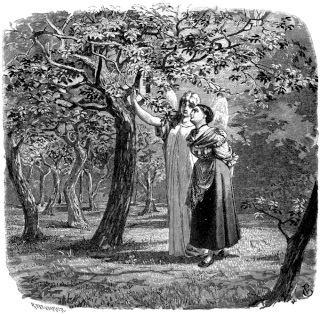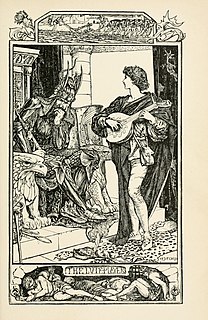Related Research Articles

"Snow-White and Rose-Red" is a German fairy tale. The best-known version is the one collected by the Brothers Grimm. An older, somewhat shorter version, "The Ungrateful Dwarf", was written by Caroline Stahl (1776–1837). Indeed, that appears to be the oldest variant; no previous oral version is known, although several have been collected since its publication in 1818. Oral versions are very limited regionally. The tale is of Aarne-Thompson type 426.
The Aarne–Thompson–Uther Index is a catalogue of folktale types used in folklore studies. The ATU Index is the product of a series of revisions and expansions by an international group of scholars: Originally composed in German by Finnish folklorist Antti Aarne (1910), the index was translated into English, revised, and expanded by American folklorist Stith Thompson, and later further revised and expanded by German folklorist Hans-Jörg Uther (2004). The ATU Index, along with Thompson's Motif-Index of Folk-Literature (1932) is an essential tool for folklorists.

The Frog Princess is a fairy tale that has multiple versions with various origins. It is classified as type 402, the animal bride, in the Aarne–Thompson index. Another tale of this type is Doll i' the Grass.

Snegurochka (diminutive) or Snegurka, or The Snow Maiden, is a character in Russian fairy tales.

"Maid Maleen" is a German fairy tale collected by the Brothers Grimm, number 198.

"The Hut in the Forest" is a German fairy tale collected by the Brothers Grimm. Andrew Lang included it in The Pink Fairy Book (1897). It is Aarne-Thompson type 431.

"The Girl Without Hands" or "The Handless Maiden" or "The Girl With Silver Hands" or "The Armless Maiden" is a German fairy tale collected by the Brothers Grimm. It is tale number 31 and was first published in the 1812 edition of Children's and Household Tales. The story was revised by the Grimm brothers over the years, and the final version was published in the 7th edition of Children's and Household Tales in 1857. It is Aarne-Thompson type 706.
The Armless Maiden is a Russian fairy tale collected by Alexander Afanasyev in Narodnye russkie skazki.

The Lute Player, The Tsaritsa Harpist or The Tsaritsa who Played the Gusli, is a Russian fairy tale. It was published by Alexander Afanasyev in his collection Russian Fairy Tales, as number 338. Andrew Lang included it in The Violet Fairy Book (1901).
Prunella is an Italian fairy tale, originally known as Prezzemolina. Andrew Lang included it in The Grey Fairy Book. It is Aarne-Thompson type 310, the Maiden in the Tower.

"The Twelve Brothers" is a German fairy tale collected by the Brothers Grimm in Grimm's Fairy Tales. Andrew Lang included it in The Red Fairy Book.
Penta of the Chopped-off Hands or The Girl With the Maimed Hands is an Italian literary fairy tale written by Giambattista Basile in his 1634 work, the Pentamerone.
"The Pink" or "The Carnation" is a German fairy tale collected by the Brothers Grimm in Grimm's Fairy Tales as tale number 76.
"The Ass", "The Donkey", or "The Little Donkey" is a German fairy tale collected by Brothers Grimm compiled in the Grimm's Fairy Tales.
"The Turnip" is a German fairy tale collected by the Brothers Grimm in Grimm's Fairy Tales.

Little Wildrose is a Romanian fairy tale. Andrew Lang included it in The Crimson Fairy Book.
Grateful dead is both a motif and a group of related folktales present in many cultures throughout the world.
The Calumniated Wife is a motif in traditional narratives, numbered K2110.1 in Stith Thompson's Motif-Index of Folk-Literature. It entails a wife being falsely accused of, and often punished for, some crime or sin. This motif is at the centre of a number of traditional plots, being associated with tale-types 705–712 in the Aarne–Thompson–Uther Index of tale-types.

King Lindworm or Prince Lindworm is a Danish fairy tale published in the 19th century by Danish folklorist Svend Grundtvig.
In folkloristics, "The Animal as Bridegroom" refers to a group of folk and fairy tales about a human woman marrying or being betrothed to an animal. The animal is revealed to be a human prince in disguise or under a curse. Most of these tales are grouped in the international system of Aarne-Thompson-Uther Index under type ATU 425, "The Search for the Lost Husband". Some subtypes exist in the international classification as independent stories, but they sometimes don't adhere to a fixed typing.
References
- 1 2 D. L. Ashliman, The Snow Child: folktales of type 1362
- 1 2 3 4 Jan M. Ziolkowski Fairy Tales from Before Fairy Tales: The Medieval Latin Past of Wonderful Lies p 42 ISBN 9780472033799
- 1 2 Nicolas Balachov, (1984). "Le developpement des structures narratives du fabliau a la nouvelle". in Gabriel Bianciotto, Michel Salvat. Épopée animale, fable, fabliau. Publication Univ Rouen Havre. pp. 30-32.. ISBN 978-2-13-038255-3.
- ↑ Jan M. Ziolkowski, (ed. and trans.), The Cambridge Songs (‘Carmina Cantabrigensia’), The Garland Library of Medieval Literature, Series A, 66 (Garland: New York, 1994), no. 14.
- ↑ D. L. Ashliman, The Snow Maiden: foltales of type 703*